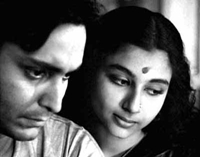Is It Really a Great Movie? Part Thirty-Five: The Apu Trilogy
by dan heaton
Using Roger Ebert's Great Movies book as a guide, this series of articles will focus on all films included on his list that previously have escaped my notice. Since all lists are subjective, I am not treating Ebert's choices as the essential selection of films. However, his essays offer the perfect chance for me to explore both classics and lesser-known pictures from around the globe.

India’s Satyajit Ray is often listed among the world’s great filmmakers, largely due to his work on the Apu Trilogy in the late 1950s. His debut picture was 1955’s Pather Panchali, which introduced Apu and his family. The film earned international acclaim and numerous awards from critics. Aparajito followed in 1956 and continued the story while earning more accolades. After shooting a few other movies, Ray concluded the trilogy in 1959 with The World of Apu. These famous films were based on the works of Bengali author Bibhutibhushan Bandopadhyay and are connected to the writer’s real life. They also include signature music from the then-unknown Ravi Shankar, who later became an internationally regarded musician. Changing the Indian film industry and giving worldwide audiences an unprecedented look at Indian culture, the Apu Trilogy remains a favorite series of films among many cinema lovers.
The grand story begins with Pather Panchali, translated into English as “song of the little road.” This description feels accurate. The slow-moving picture focuses on the minor events in the daily lives of young Apu (Subir Bannerjee) and his older sister Durga (Uma Das Gupta), who frequently takes center stage. The family lives in rural Bengal during the 1920s and faces the typical struggles to make a living. The father Harihar (Kanu Bannerjee) is an idealistic dreamer, but his skills don’t transform into actual success. The mother Sarbojaya (Karuna Bannerjee) is more pragmatic and hopes for a better life, but she also can be especially rough on her free-spirited daughter. Her frustration is understandable due to the continued absence of Harihar, but grows a bit tiring after a few instances. Very little happens during this tedious story, but present is a sweet tone that is missing from the sequels. While I wouldn’t call the film a riveting viewing, a certain charm does exist within the pastoral environment. Unfortunately, melodrama takes over during the final segments, which feel a bit too contrived to really generate the expected impact. Uma Das Gupta is engaging as Durga, but the overall effect is fairly underwhelming.
Aparajito shows the family after their move to Benares, which is more hectic than the quiet rural setting of the previous movie. Apu (Smaran Ghosal) is now a teenager and appears to be following in the footsteps of his father’s idealistic ways. The opportunity for schooling in Calcutta appears, which takes him away from the lonely Sarbojaya (Karuna Bannerjee). She dreads his departure and spends her days pining for his return, but Apu seems to care little for family time. Unfortunately, this was the toughest installment for me to sit through and dragged considerably. Bannerjee gives her best shot to draw our sympathy, but lengthy moments of her waiting for Apu grow tired quickly. Fans of the first installment will probably enjoy the sequel, but viewers with a lukewarm response like me will probably struggle even more with the extremely slow pace.
Finally, The World of Apu shifts even further into the modern world with an adult Apu trying to find his way. This picture’s early moments are surprisingly engaging and seem to promise a different type of movie. At the last minute, Apu decides to join a friend and attend a wedding, which leads to stunning results. Strange circumstances and traditions cause him to leave with a wife, which offers a promising set-up. Unfortunately, this situation drifts into too much sentimentality, leading to a frustrating third act showcasing Apu’s selfishness. The finale does reveal some hope, but it feels hollow considering the numerous sorrows that have occurred over the course of the Trilogy. Even as an adult, Apu is only mildly interesting and fails to do the heavy lifting needed to sell the drama.
Roger Ebert describes how “the great, sad, gentle sweep of ‘The Apu Trilogy’ remains in the mind of the moviegoer as a promise of what film can be.” This elegant description promises a fascinating story that represents groundbreaking cinema. The sharp differences between my reaction and those of Ebert and most critics raises several key issues. Is it possible to watch a film today and just appreciate its historical importance? Or do we need a modern-day connection that might be lacking in certain types of movies? Critics and experts in the ‘50s and ‘60s had rarely seen pictures of this type and had never watched anything similar from India. Is my tepid response due to the wide array of international pictures available today? The second issue is the general downfall of melodrama, which doesn’t go very far in the 21st century. The devastating moments for Apu and his family are designed to make us sad, but they feel like a puppet master tugging at strings to manipulate the audience. I recognize the reasons that critics love the Apu trilogy, but I definitely rank the films well below Great Movie status.
Check out the entire series of "Is It Really a Great Movie?" articles here.
Copyright (c) 2007 erasing clouds |
|